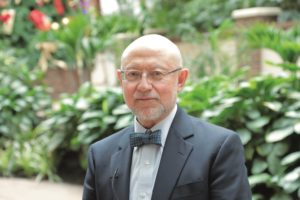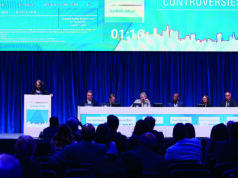 Fedor Lurie started his medical career in Ekaterinburg, Russia, on the east side of the Ural mountain chain. Now a long-time prominent figure in some of the largest venous and vascular societies in the USA, Lurie speaks to Venous News about the path that led him here—a career filled with mysteries, mentors, and memorable cases.
Fedor Lurie started his medical career in Ekaterinburg, Russia, on the east side of the Ural mountain chain. Now a long-time prominent figure in some of the largest venous and vascular societies in the USA, Lurie speaks to Venous News about the path that led him here—a career filled with mysteries, mentors, and memorable cases.
How did you decide to become a medical doctor, and what led you to the venous specialist field?
I grew up fascinated by mysteries. I dreamed of travelling the world, finding the Loch Ness monster, discovering lost tribes of the Amazon jungle, solving the secret of the Bermuda triangle, and flying to other worlds in search of extra-terrestrial intelligent life. Reading mostly science fiction during my teens, my interest in science and maths grew. I was ready to chose a career in science when I came across an article in a popular science magazine written by a physician. It described solving challenging clinical cases. This was a turning point; I decided to go to medical school. At first, I was overwhelmed by how much one needs to learn to be able to practice. But the very first clinical rotation confirmed exactly what led me to choose a medical career—every single patient is a mystery that is challenging to solve. Seeing pain and suffering strengthened my desire to solve those mysteries for as many patients as I can. My interest in maths and physics was a factor in choosing cardiovascular surgery as my specialty, but getting into the venous field was accidental. My department chair assigned me the task of developing a venous surgery division; I was disappointed. As a junior faculty member who just completed a series of complex aortic reconstructions, I was looking forward to continuing on the aortic track. It did not take long, however, to find another mystery: venous valves. Kistner, Raju, and Sottiurai described different techniques of deep vein valve repair, but indications to this surgery and functional assessment of results remained unclear. This mystery set me off on a journey that is still far from completion.
Who were your mentors, and how have they shaped your career?
I was fortunate to have great mentors throughout my career. My surgical training was in the department of Professor Lidsky, who started using heparin for treatment of deep vein thrombosis (DVT) in the 1940s and wrote the first textbook on chronic venous disease. I had the privilege to learn the importance of knowledge promulgation and consensus building from the great master Bo Eklöf. Robert L Kistner (he prefers “Bob”) became more than a mentor: he and his wife Adelaide made my wife Galina and me a part of their family. Years of working with Bob gave me an opportunity to observe his highly individualised patient approach, unmatched clinical skills, and most importantly, continuous quest for new treatment options based on in-depth patient observation.
You were president of the American Venous Forum (AVF) in 2014–2015. As someone with a long-term involvement in the AVF, what were you most proud of during your time as president, and how was your work with the AVF continued?
Prior to my presidency, the Board established a priority for strategic planning. In 2014, we developed a strategic plan with several objectives. Our scientific objective was to identify and address the major gaps in knowledge related to venous and lymphatic disorders. In 2015 we developed a Day of Science and Innovation—a one-day meeting with participation from the US Food & Drug Administration (FDA), National Institute of Health (NIH) and industry and clinical researchers, which drove identification of research priorities.
The administrative objective was to increase the diversity of the AVF membership. Today, the AVF is a truly multispecialty society. The strategic objective was to develop the health policy strategy. In 2014–15 we engaged in discussions with the Centers for Medicare and Medicaid Services (CMS) leading to our participation in the Medicare Evidence Development & Coverage Advisory Committee (MEDCAC), developed relationships with private payers influencing their policies, and started building a process for more robust and credible guidelines.
You are the principal author of a recently published guidelines document on compression therapy following venous interventions. Which were the collaborating societies, and what were the key recommendations of these guidelines?
We had asked several societies to participate in the development of these guidelines before the work began. The Society for Vascular Surgery, the American College of Phlebology, the Society for Vascular Medicine, and the International Union of Phlebology nominated their representatives and participated in the entire process of evidence collection, analysis, grading, and making recommendations.
The key recommendations are specific to the treatment modality, and the disease stage. Although the level of evidence deserves major improvements, it is clear that compression therapy remains to be a key component of comprehensive venous care, especially in advanced stages of chronic venous disease.
What are some of your other current research interests?
My main research interest still relates to haemodynamics, but it is more focused now on biological effects of abnormal blood flow. Together with my previous research fellow Maxim Shaydakov, we have looked at the molecular mechanisms in endothelial cells around the normal human deep vein valve. This has not been done before, and somewhat surprising findings are the base for the current investigation of the mechanisms involved in the DVT initiation. On the arterial side, we also found an interesting relationship between the shear rate of the blood flow in the carotid arteries and the risk of stroke. Our Vascular Surgery fellow Nizar Hariri recently published these results in the Journal of Vascular Surgery.
Another fascinating area is defining the appropriate dose of compression therapy. Recently developed technology allows interface pressure measurements in routine clinical practice. I believe that looking at clinical outcomes with an objectively measured dose of compression will change our clinical practice. Together with my current research fellow Junjie Ning, we are exploring this intriguing subject.
In the last year, which research paper(s) have you found particularly interesting, and why?
This is a hard question to answer within a few lines. The field of veins and lymphatics is so broad that it is increasingly challenging to keep up with new information. The most interesting for me are the papers that open a new side of a known subject, or those that spark the drive for further research. Two recent papers fall in these categories. The first is “Risk factors associated with the venous leg ulcer that fails to heal after one year of treatment” by Raffi Melikian et al from Tufts University, Boston, USA. It suggests that deep vein disease, and particularly deep reflux plays a major role in ulcer resistance to treatment. Current obsession with iliac vein obstruction has overshadowed this aspect of the natural history of venous ulcers. I hope that this paper will trigger some interest in researching the role of deep vein reflux. The paper was published in the Journal of Vascular Surgery: Venous and Lymphatic Disorders (JVS-VL).
Another interesting paper came from Ulka Sachdev and colleagues at the University of Pittsburgh, USA and was also published in the JVS-VL. The authors of “Suppressed networks of inflammatory mediators characterize chronic venous insufficiency” took a more comprehensive look at the role of inflammation in chronic venous insufficiency than in the majority of recent publications. In addition to measuring inflammatory mediators, they have investigated their interconnectivity showing its significant disruption in the blood obtained from refluxing veins. This paper raises many new questions that are vitally important for our understanding of the biology of venous disease.

What do you think are the main challenges currently facing the field?
The biggest challenge in the venous field is the lack of high-level evidence. It applies to both clinical and basic sciences. Pathogenetic mechanisms of venous disease are under-investigated and poorly understood. This means the foundation of many current treatments and management options is quite shaky. The current clinical evidence is often based on underpowered studies, and studies that failed replication attempts. Today’s regulatory and ethical environment requires a much stronger base for clinical decision-making.
Could you describe a particularly memorable case you have had, and what you learned from it?
A 36-year-old mother of three came with a venous ulcer due to primary chronic venous disease and great saphenous vein reflux. She was previously denied insurance coverage because she was asymptomatic. It turned out that years ago, she quit her standing job because of her symptoms, and started home-based business with her husband, so that she could sit at work. She then became “asymptomatic” until she developed an ulcer. This case not only shows the importance of proper clinical investigation of every patient, but also demonstrates how ignoring true clinical disease definitions leads to tragedies for people.
In your career thus far, what has been your proudest moment?
The proudest moment in my professional carrier has been becoming president of the American Venous Forum. Over the years of working with AVF—the most respected venous society in the world—I developed close friendships with many of the past presidents, but always looked up to them. To have my name listed next to these giants of the venous field is a true professional honour.
What advice would you give to physicians and venous specialists who are at the beginning of their careers?
Remember that the only reason for your existence as a specialist is your ability to provide the best care for your patients. Pursuing other goals damages both you and the specialty that you choose.
Outside of work, how do you most like to spend your time?
The most enjoyable time to me is time spent with my family. When children and grandkids are not around, I enjoy playing scrabble with my wife. We also like travelling; learning about different cultures is always fun. My long-time hobby is fishing: not only for the thrill and the sport of it, but being outdoors in the early morning or at sunset is a great way to relax.
Fact File
Academic appointments (selected)
2016–present: Adjunct Research Professor, Division of Vascular Surgery, University of Michigan, Ann Arbor, USA
2012–present: Associate Director, Jobst Vascular Institute, ProMedica, Toledo, USA
2000–2012: Clinical professor, Department of Surgery, John A Burns School of Medicine of Hawaii, Honolulu, USA
1989–1995: professor of Surgery, Department of Surgery, Ural Medical Academy, Ekaterinburg, Russia
Society appointments (selected)
2016–present: Society for Vascular Surgery: Research Committee member
2016–present: Society for Vascular Surgery: Program Committee member
2015–present: American Venous Forum: Chairman, Science and Innovation Day committee
Past society appointments (selected)
2015–2017: American Venous Forum Foundation: President
2014–2015: American Venous Forum: President
2011–2014: Society for Vascular Surgery: Director, Board of Directors
2006–2011: American Venous Forum Foundation: Director, Board of Directors
2004–2012: Pacific Vascular Symposium: Co-Chairman
1982–1986: Urals Society of Young Scientists: Chairman
Memberships
American Heart Association
American Venous Forum
American Venous and Lymphatic Society
Society for Vascular Surgery
European Venous Forum (Honorary Member)
German Phlebology Society (Corresponding Member)












